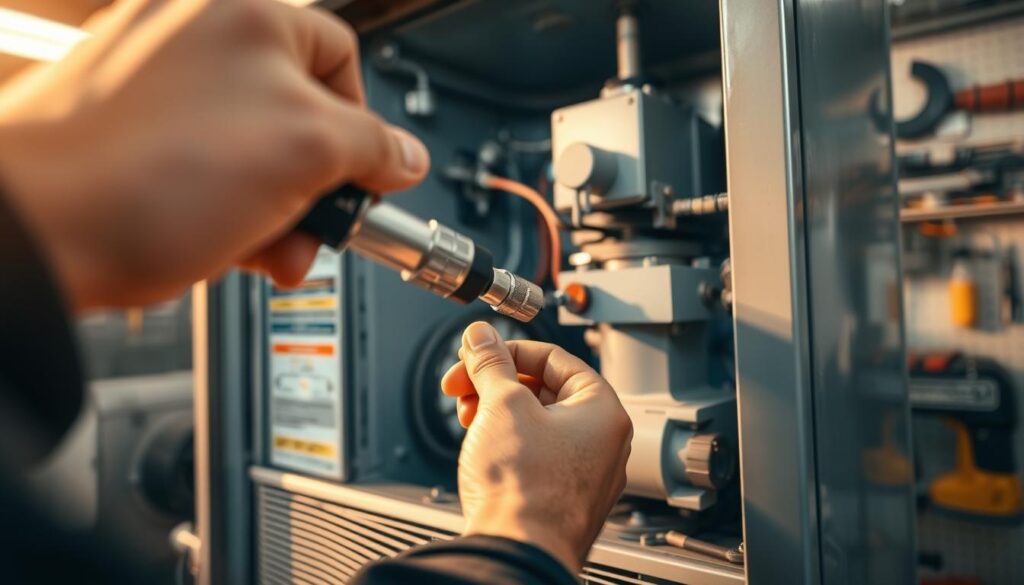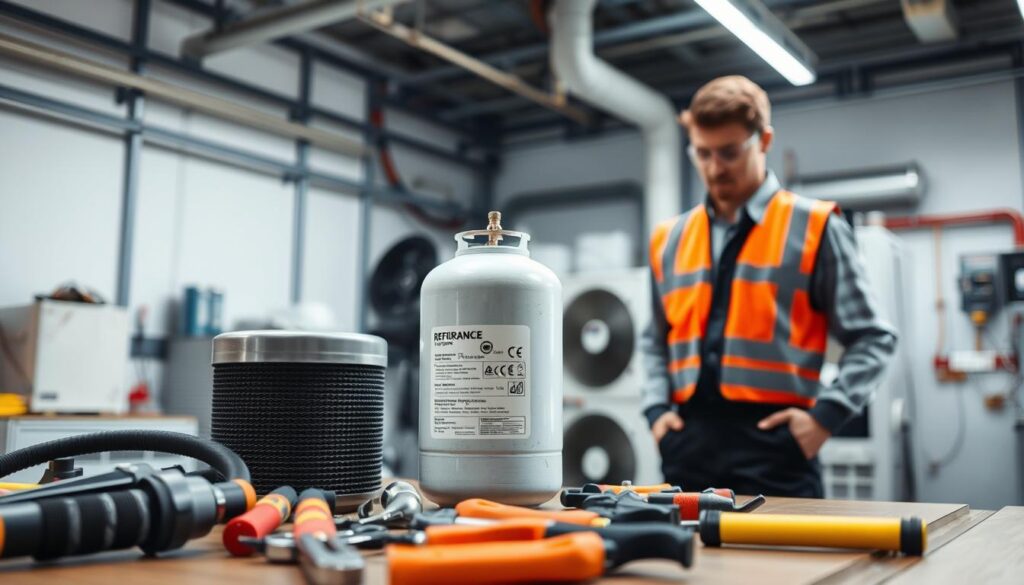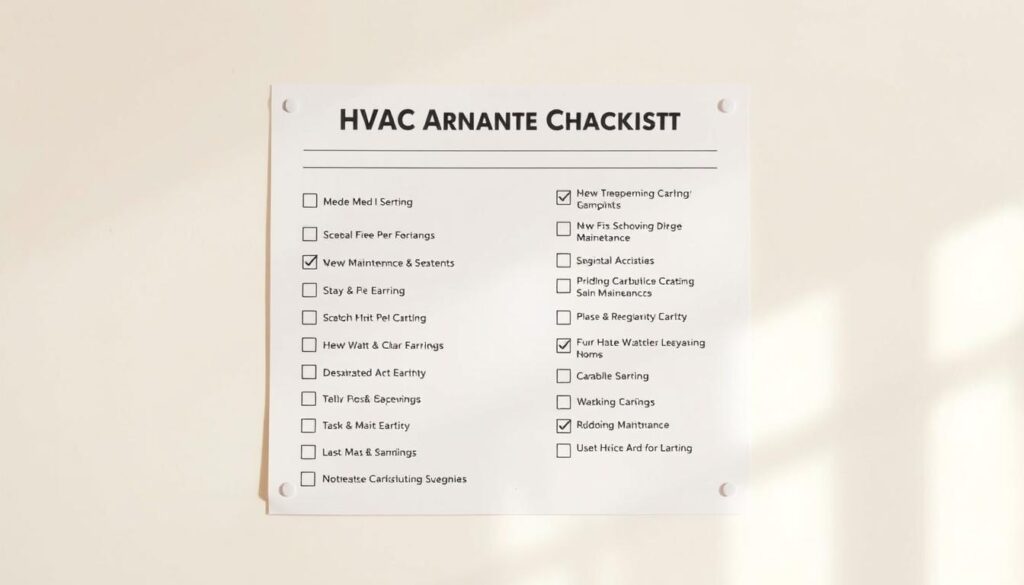Affiliate Disclosure
HVAC Guide Guys is a participant in the Amazon Services LLC Associates Program, an affiliate advertising program designed to provide a means for sites to earn advertising fees by advertising and linking to Amazon.
How to Add Freon to HVAC Unit? Ever wondered why your air conditioning isn’t working right? Learning how to add freon to your HVAC unit might fix the problem. Refrigerant is key to your cooling system, changing from liquid to gas to cool your air.

A well-charged HVAC system works best and saves energy. If refrigerant levels are low, your cooling drops, energy costs rise, and damage can happen. Adding freon seems simple, but it needs special skills and care.
Experts say to be careful with adding freon. It’s a complex task with strict rules to protect your system and the environment.
Key Takeaways
- Refrigerant is vital for cooling your home
- Low refrigerant levels hurt system performance
- Get a pro for freon recharge
- Environmental rules guide refrigerant use
- Regular upkeep avoids expensive repairs
Table of Contents
Understanding HVAC Refrigerant Basics
Your home’s air conditioning system relies on a key component: refrigerant. Many homeowners don’t fully understand it. Knowing how refrigerant works is vital for keeping your home cool and comfy.
Refrigerants are special chemicals that help your AC cool the air. The process of adding refrigerant is more than just pouring liquid into your system.
How Refrigerant Circulates Through Your System
The refrigeration cycle has several important steps:
- Absorption of heat from indoor air
- Compression of refrigerant
- Heat release through outdoor condensing unit
- Expansion and cooling of refrigerant
Modern Refrigerant Landscape
Today’s HVAC systems use different refrigerants than older ones. Changes in environmental impact and regulations have shaped the refrigerant industry.
| Refrigerant Type | Environmental Impact | Usage Status |
|---|---|---|
| R-22 (Freon) | High Ozone Depletion | Phased Out |
| R-410A | Lower Environmental Impact | Currently Preferred |
| R-32 | Minimal Global Warming Potential | Emerging Standard |
Environmental Regulations and Safety
The Environmental Protection Agency (EPA) has strict rules for refrigerant handling. Only certified professionals can perform air conditioner freon refill services. This ensures both environmental safety and system efficiency.
“Understanding refrigerant is key to maintaining a cool, efficient home environment.” – HVAC Professional
Choosing the right refrigerant and keeping the right levels is essential for your AC’s performance and life span.
Signs Your HVAC Unit Needs Refrigerant
Spotting low refrigerant levels early can save you from expensive fixes and keep your cooling running smoothly. It’s key to know when your HVAC needs a refrigerant top-up to keep your home comfy and your system in top shape.
Here are some signs you might need to recharge your HVAC:
- Warm air blowing from vents instead of cool air
- Increased energy bills without explanation
- Unusual hissing or bubbling noises near the unit
- Visible ice formation on refrigerant lines or evaporator coils
Refrigerant levels affect how well your system cools. Low refrigerant means your air conditioner works harder but cools less. This can damage it over time.
| Warning Sign | Potential Refrigerant Issue |
|---|---|
| Warm Air Output | Likely refrigerant leak or low charge |
| Ice Buildup on Coils | Indicates restricted refrigerant flow |
| Reduced Cooling Efficiency | Suggests need for hvac unit refrigerant replacement |
If you see these signs, get a pro HVAC tech to check your system. Trying to fix it yourself can make things worse.
Safety Precautions and Required Equipment
Working with refrigerants in HVAC repair needs strict safety rules and special tools. It’s key to keep yourself and the environment safe while doing hvac maintenance freon refill.
Essential Protective Gear
Professional HVAC techs must wear full protective gear to avoid chemical exposure. Your safety gear should include:
- Chemical-resistant respirator mask
- Thick protective gloves
- Safety goggles or full-face shield
- Thick coveralls or protective suit
- Steel-toed work boots
Required Tools and Materials
Handling refrigerants well needs special tools for safe hvac maintenance freon refill.
| Tool Category | Specific Equipment |
|---|---|
| Measurement Tools | Digital manifold gauge set |
| Safety Equipment | Refrigerant recovery machine |
| Personal Protection | Chemical-resistant gloves |
| Handling Tools | Refrigerant charging hoses |
Environmental Considerations
Managing refrigerants responsibly is more than just personal safety. Proper handling and disposal of refrigerants are critical for environmental protection. Always follow EPA guidelines when doing hvac repair freon addition to lessen ecological harm.
Protect yourself, your equipment, and the environment by following strict safety protocols during refrigerant handling.
How to Add Freon to HVAC Unit
Adding freon to an HVAC unit needs careful preparation and precise steps. Before starting, make sure you have the right tools and know the important steps.
Getting ready for an HVAC refrigerant recharge is crucial. Here are the key steps to follow:
- Use a professional leak detector to find any refrigerant leaks.
- Check that you have the right refrigerant for your HVAC system.
- Wear the right safety gear, like gloves and safety glasses.
- Make sure the outside temperature is above 55°F.
The recharge process has several important steps:
- Turn off the air conditioning system completely.
- Connect professional refrigerant manifold gauges to the service ports.
- Check the current system pressure readings.
- Slowly add the correct refrigerant while watching the pressure levels.
- Disconnect the gauges and check if the system works right.
Warning: Handling refrigerant wrong can harm your HVAC system and break environmental laws. If you’re not sure about any step, call a licensed HVAC pro. They can safely recharge the refrigerant for you.
Professional technicians have the skills and tools to do a safe and accurate refrigerant recharge.
Professional Licensing Requirements
When it comes to hvac repair freon addition, the law is clear. Only certified professionals can legally handle refrigerants. The U.S. Environmental Protection Agency (EPA) strictly regulates who can perform hvac maintenance freon refill services. This is to protect both the environment and public safety.
Getting the right certification involves a detailed process. It makes sure technicians know how to handle refrigerants safely. The EPA requires specific training and a test to qualify for different certifications.
- Section 608 Certification is needed for any technician working with refrigeration and air conditioning equipment
- Technicians must pass a written exam to show they know about refrigerant management
- Different certifications cover various equipment and refrigerant scales
The certification levels include:
- Type I: Small appliances
- Type II: High-pressure refrigerants
- Type III: Low-pressure refrigerants
- Universal: Covers all refrigerant types
Handling refrigerants without a license can lead to big fines. Fines can go up to $37,500 per day for breaking the rules. This shows how important it is to work with a licensed professional for any HVAC refrigerant services.
“Proper certification is not just a legal requirement, it’s a commitment to safety and environmental responsibility.” – EPA Guidelines
For homeowners, this means you should always hire a certified technician for any refrigerant-related HVAC maintenance or repair. Your system’s performance and your environmental compliance depend on professional expertise.
Common Mistakes to Avoid During Recharge
Recharging your HVAC system needs precision and careful attention. Mistakes during the ac freon top-up process can damage your cooling system. They can also pose safety risks.

Knowing the common pitfalls can help you avoid costly errors. It also protects your air conditioning investment.
Overcharging Risks
Overfilling your system during an hvac refrigerant leak fix can cause big problems. Too much refrigerant can:
- Increase system pressure beyond safe levels
- Cause compressor failure
- Reduce overall cooling efficiency
- Lead to expensive mechanical damage
“Precision is key when adding refrigerant to your HVAC system.” – HVAC Professional
Pressure Reading Errors
Accurate pressure measurements are crucial during refrigerant recharging. Wrong readings can lead to:
- Insufficient cooling performance
- Increased energy consumption
- Potential system breakdown
Safety Protocol Violations
Ignoring safety protocols during refrigerant handling is dangerous. Always wear protective gear. Follow manufacturer guidelines when doing an ac freon top-up.
Remember: When in doubt, consult a professional HVAC technician. They ensure safe and effective refrigerant recharging.
Cost Considerations for HVAC Refrigerant Service
Knowing the costs of air conditioner freon refill helps you make smart choices. The prices for refrigerant services change based on several important factors.
Common costs for refrigerant service include:
- Refrigerant type
- System size and complexity
- Labor rates in your area
- Current market prices for refrigerant
Expect to pay about $67 per pound of refrigerant. Most HVAC units need up to 10 pounds. This could cost you $670 for a full recharge. HVAC technicians usually charge between $100 and $350, based on your system’s needs.
Pro tip: Regular maintenance can help reduce the frequency and cost of HVAC unit refrigerant replacement.
DIY refrigerant recharging might seem cheap, but it’s risky. Professionals ensure:
- Proper refrigerant handling
- Accurate system diagnosis
- Compliance with environmental regulations
- Long-term system performance
Homeowners looking to save money should think about preventive maintenance. Regular system checks can catch problems early, saving you from expensive repairs.
Preventive Maintenance Tips
Keeping your HVAC system in top shape needs regular care. Proper maintenance and freon refill can make your cooling system last longer. This also helps avoid expensive repairs.

Regular system checks are key for best performance. Your HVAC system must be watched closely. This ensures it works well and avoids problems.
Routine Inspection Strategies
- Do monthly visual checks on your HVAC unit
- Check air filters every 30-90 days
- Listen for odd sounds when it’s running
- Look for wear on refrigerant lines
Leak Detection Techniques
Finding refrigerant leaks early is vital. This helps recharge your HVAC system right. Experts use special tools to spot problems:
| Detection Method | Accuracy | Cost |
|---|---|---|
| Electronic Leak Detector | High | $$ |
| UV Dye Test | Medium | $ |
| Soap Bubble Method | Low | $ |
Seasonal Maintenance Schedule
Each season needs its own HVAC care plan. Make a detailed schedule to keep your system in great shape all year.
- Spring: Clean outdoor units, check refrigerant levels
- Summer: Watch how your system is doing, change filters often
- Fall: Get ready for heating, check electrical connections
- Winter: Do minimal cooling system upkeep
Annual checks by pros are the best way to keep your HVAC running well. Regular maintenance stops sudden breakdowns and boosts your system’s performance.
When to Replace vs. Recharge
Choosing between fixing an hvac refrigerant leak and replacing the whole unit is tough. The age and how well your HVAC system works are key to this choice.
Here are signs you might need a new HVAC unit:
- Unit is 15-20 years old
- Frequent repair history
- Repair costs approach replacement price
- Inefficient cooling performance
- Persistent refrigerant leaks
Think about the long-term costs. An older unit might seem cheaper to fix, but constant repairs can cost more than a new, efficient model.
Modern HVAC systems have big benefits:
- Improved energy efficiency
- Lower utility bills
- Advanced cooling technologies
- Enhanced environmental performance
Pro tip: Get a professional HVAC technician to check your system. They can suggest the best option for your needs.
Getting a new HVAC system can save you money and make your home more comfortable over time.
Conclusion
Keeping your HVAC system’s refrigerant levels right is key for cool air and a long-lasting system. Adding freon to your HVAC unit should be done by pros for safety and best results. DIY attempts can be tricky and risky without the right training and tools.
Your HVAC system is a big investment in your home’s comfort. Regular checks and timely refrigerant recharge can avoid expensive repairs and make your cooling last longer. Spotting problems early and fixing them fast keeps your system running well and saves energy.
This guide offers helpful tips, but safety and following the law are always first. Certified HVAC techs have the skills, tools, and licenses to work with refrigerants safely. If you’re unsure about anything, it’s best to get a pro’s help to protect your system.
Being proactive and making smart choices are crucial for a well-working cooling system. Take the time to learn about your HVAC’s needs. And don’t be afraid to ask for expert advice when you need it.

